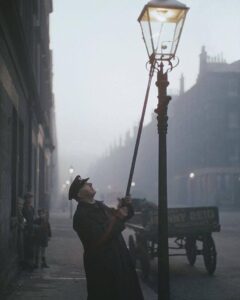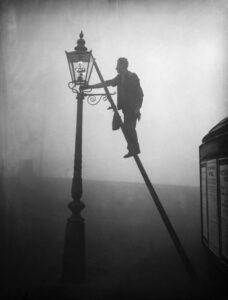 As evening arrives, and the streets grow dark, the streetlights begin to light up. When we go out to drive in the nighttime, we take for granted that the streets won’t be quite as dark as the night, because the streetlights will add a little bit of light to show you where the roads, corners, and even pedestrians are. We take all that for granted, but it wasn’t always that way. Electric streetlights came into being in Paris in 1881, but it would be quite a while before all the towns and cities of the world would have them.
As evening arrives, and the streets grow dark, the streetlights begin to light up. When we go out to drive in the nighttime, we take for granted that the streets won’t be quite as dark as the night, because the streetlights will add a little bit of light to show you where the roads, corners, and even pedestrians are. We take all that for granted, but it wasn’t always that way. Electric streetlights came into being in Paris in 1881, but it would be quite a while before all the towns and cities of the world would have them.
That brings us to the now non-existent occupation of the lamplighter. It sound self-explanatory profession from its name, but there was much more to it than simply lighting a lamp at night. Newspapers from the past can better explain the actual job of the lamplighter. When advertisements were posted for the job of lamplighter, such as the “Public Notice” which appeared in the Beeston Gazette and Echo, July 1928: “Applications are invited for the post of Lamplighter for the ensuing Lighting period. The person appointed will be required to light, extinguish, and clean the lamps. Wages £2 per week.” The Beeston Gazette and Echo of July 21, 1928, went on to say, “And so, as a lamplighter, you would be required to light lamps at dusk, extinguish them again, whilst also keeping them in good repair. This  particular position, for the parish of Gedling in Nottinghamshire, would pay £2 a week.” That would be approximately £91 ($114.64 US) in today’s money. No, the pay wasn’t great then or now, but in small towns it probably wouldn’t take long to do most of the work. Still, maintenance and cleaning added to the work.
particular position, for the parish of Gedling in Nottinghamshire, would pay £2 a week.” That would be approximately £91 ($114.64 US) in today’s money. No, the pay wasn’t great then or now, but in small towns it probably wouldn’t take long to do most of the work. Still, maintenance and cleaning added to the work.
Also, remember that the job was year-round and in every season. It wouldn’t make sense to ride a bicycle, or these days, a car, take a horse or any other vehicle to go from corner to corner lighting the lamps. So they walked, and walked!! One lamplighter named John Maher, recorded a record of 150,000 miles. His story was told in the Prescot Reporter, and Saint Helens General Advertiser. John Maher is described as one of the “unsung heroes” of Saint Helens, “whose presence in the community is taken for granted and whose necessity is rarely proclaimed.” Prescot Reporter and St. Helens General Advertiser went on to say on April 21, 1939, “For 43 years Maher has ‘been pounding the pavements of St Helens,’ during which it was estimated that he covered  150,000 miles, in all weathers. At the age of 64, the lamplighter had…worked every hour in the day. His day commenced just before dawn and ended after sundown. He also worked four hours during the interim period cleaning, and as the times of dawn and sunset are always changing, Mr. Maher has to change the times of his going to work accordingly.”
150,000 miles, in all weathers. At the age of 64, the lamplighter had…worked every hour in the day. His day commenced just before dawn and ended after sundown. He also worked four hours during the interim period cleaning, and as the times of dawn and sunset are always changing, Mr. Maher has to change the times of his going to work accordingly.”
The life of a lamplighter was a hard one once described like this, “I may say that as a lamp-lighter I am exposed to all weathers and have a lot of broken rest and excessive walking. Everybody notices the great improvement in me since I took Phosferine. I continue the remedy regularly twice a day, and I would not be without it on any account, as I consider it has given me a new lease of life.” Apparently, the job was so hard that many lamplighters took some sort of medicine to make it through their days. Clearly, we can consider ourselves blessed to have electric streetlights these days.


Leave a Reply